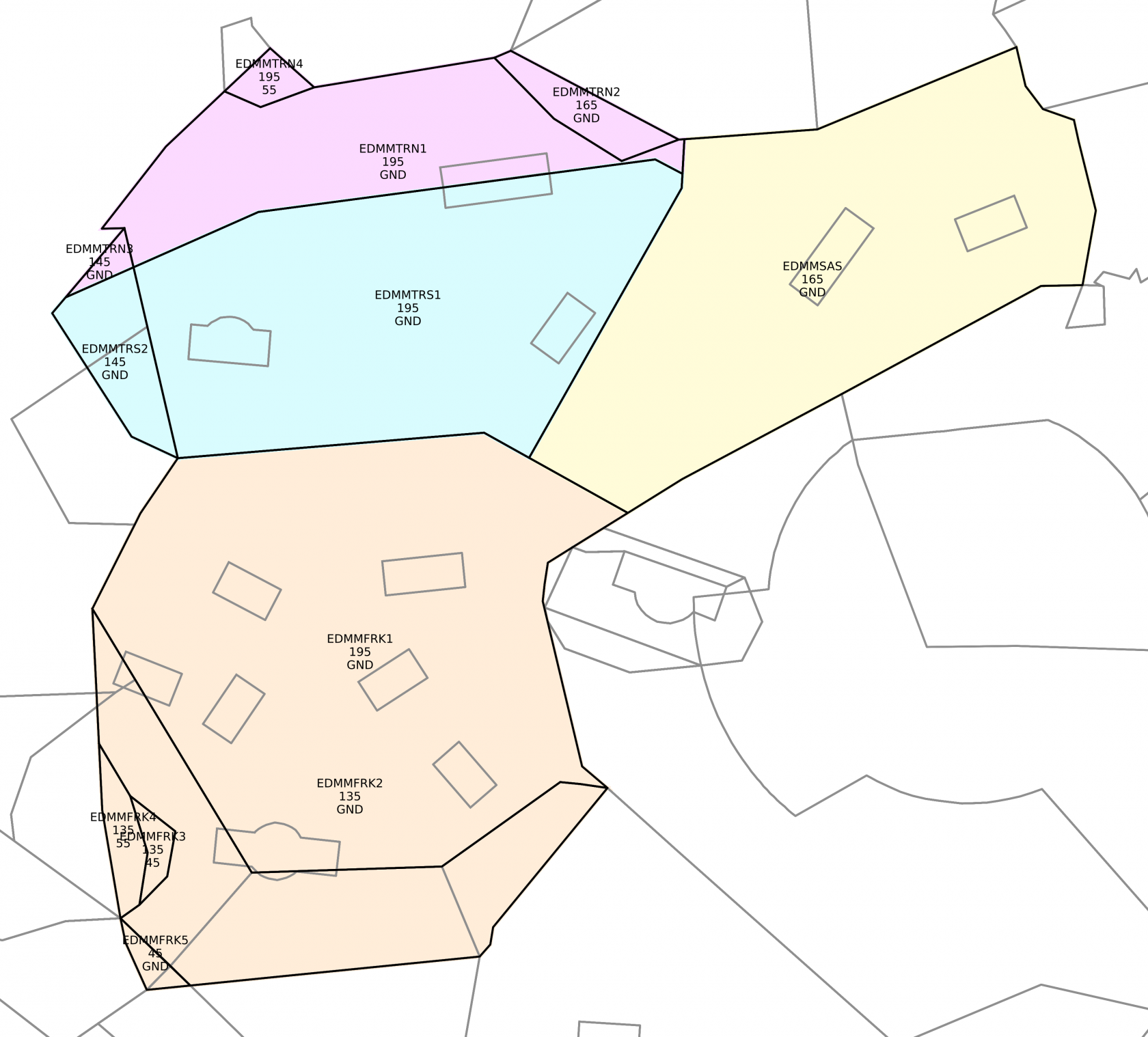Arrival - Franken Low
The Nürnberg arrival does not cover a pure arrival sector, but the fully-fledged lower sector Franken Low (FRKL) in the GND - FL195 level band. In addition to arrivals and departures to/from Nuremberg, a few transits cross the sector. Franken Low is also home to the controlled aerodrome Hof-Plauen (EDQM), as well as numerous info pointsairports with a RMZ and IFR procedures. The exact structure of the sector can be seen in the following sector chart.
Arrivals
RNAV Arrivals
The arrivals in Nürnberg have their clearance limit at the corresponding transition fix (see table) and must already be filed by the pilot in the flight plan, but explicitly cleared. Pilots must at least be BRNAV-equipped, for NON-RNAV a route must be filed according to ERL or NUB.
| Waypoint Designator |
RWY | CL Holding (MHA 5000ft) |
Remarks | |
| DODAS |
1T | 10 | left, 170° |
|
| 1V | 28 | not to be used during activity of NLFS | ||
| PIVIR | 1T | 10 | right, 204° |
|
| 1V | 28 | not to be used during activity of NLFS | ||
| LETKU | 1T | 10 | left, 042° | |
| 1V | 28 | |||
| UPALA | 1T | 10 | right, 315° | |
| 1V | 28 | |||
Approach procedure
In operating direction 28, Nürnberg has a CAT IIIb-certified ILS, as well as one RNAV and two published LOC approaches (LOC Z and LOC Y) and thus logically another localiser antenna in addition to the LOC antenna belonging to the full ILS. In operating direction 10, Nürnberg has a CAT I-certified ILS, as well as an RNAV and VOR approach.
Visual approaches may be cleared after coordination with the tower, but must be conducted in such a way that the final approach for RWY 28 approaches from the north is at least 2.5 NM (5 DME NUB), for approaches from the south the final approach is at least 5.5 NM (8 DME NUB) and for RWY 10 the final approach is at least 5 NM (4 DME NUB).
Working with the feeder position
In reality, there is no longer a feeder in Nuremberg, but due to the unrealistically high flight movements on Nuremberg Monday, this station has been retained on VATSIM.
The handover between FRKL and feeder takes place at 28 operation downwind sinking to 6000ft, at 10 operation sinking to 5000ft.
Target separation on final
There is no target separation per se and all pilots are requested to separate according to the traffic conditions on the final. Requests for separation from TWR must be implemented within 10 minutes, speed requests from TWR immediately.
With a balanced traffic flow, a separation of approx. 6 NM is usually suitable to utilise the runway as efficiently as possible. Higher separation minima due to wake vortices or similar must of course be given priority!
Departures
Handoffs
With the exception of ERL departures, departures in Nuremberg are obliged to make an initiation call on the corresponding departure frequency immediately after take-off.
Local IFR via ERL
For local IFR flights, the tower must always plan via ERL; unlike all other SIDs, the tower keeps departures via the ERL departure on frequency until they have left its AoR or there is a separation to traffic in the control zone.
Agreements
Outbound Traffic - FRKL transferring
| Receiving SCT | ADES / ADEP | COPX | XFL | RMK |
|---|---|---|---|---|
| EDMM BBG | ↑EDDN | SULUS | FL190 | -- |
| EDMM HOF | ↑EDDN | ERETO | FL190 | |
| EDMM RDG | ↑EDDN | RODIS | FL160 | |
| EDMM TRLS | ↓EDDE | NARUS | FL110 | Clear STAR |
| EDMM WLD | ↑EDDN | AKANU | FL130 | -- |
| EDGG DKB | ↑EDDN | DKB | FL130 | |
| EDGG GED | ↑EDQ* | VAGAB | FL180 | |
| EDGG HAB |
↑EDDN ↑EDQ* |
SULUS | FL180 | |
| EDGG KTG | ↑EDDN | IBAGA | FL130 | |
| SUKAD | ||||
| LKKV_APP | ↓LKKV | OKG | FL120 | |
| LKAA-W | ↑EDQM | OKG | FL170 | |
| ODOMO | ||||
| VEMUT |
Inbound Traffic FRKL receiving
| Transferring SCT | ADES/ADEP | COPX | PEL | RMK |
|---|---|---|---|---|
| EDMM ALB | ↓EDDN | DOSIS | FL140 | -- |
| UPALA | ||||
| EDMM BBG | ↓EDDN | ALL | FL200 | Vertical entries |
| EDMM GER | ↓EDDN | TABAT | FL200 | -- |
| EDMM HOF | ↓EDDN | ALL | FL200 | Vertical entries |
| EDMM RDG | ↓EDDN | RODIS | FL140 | -- |
| EDMM TRLS | ↑EDDE | BAMKI | FL160 | |
| TABAT | FL160 | |||
| EDGG DKB | ↓EDDN | LETKU | FL110 | |
| EDGG HAB | ↓EDDN | ERTES | FL130 | |
| ↓EDQ* | SULUS | FL170 | ||
| EDGG HEF | ↓EDDN | VELIS | FL170 | |
| ↓EDQ* | BOKNI | FL170 | ||
| LKKV_APP | ↑LKKV | OKG | FL110 | |
| RAPET | ||||
| VARIK | ||||
| LKAA-W |
↓EDDN ETHN ↓ETIN EDQ* |
OKG | FL180 | |
| ↓EDDE | VARIK | FL190 |

